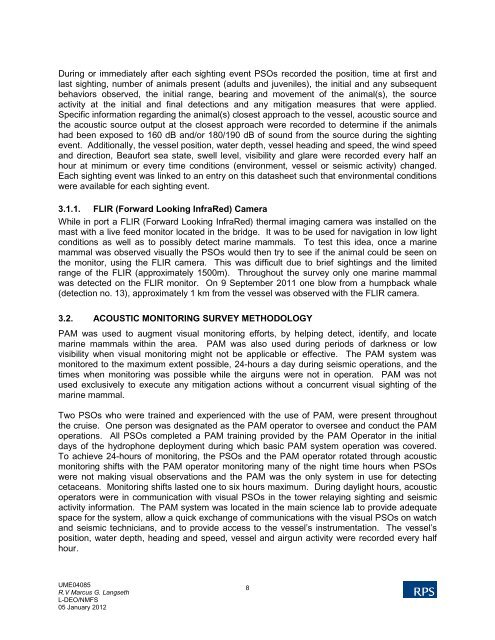90-day Monitoring Report - National Marine Fisheries Service - NOAA
90-day Monitoring Report - National Marine Fisheries Service - NOAA
90-day Monitoring Report - National Marine Fisheries Service - NOAA
Create successful ePaper yourself
Turn your PDF publications into a flip-book with our unique Google optimized e-Paper software.
During or immediately after each sighting event PSOs recorded the position, time at first and<br />
last sighting, number of animals present (adults and juveniles), the initial and any subsequent<br />
behaviors observed, the initial range, bearing and movement of the animal(s), the source<br />
activity at the initial and final detections and any mitigation measures that were applied.<br />
Specific information regarding the animal(s) closest approach to the vessel, acoustic source and<br />
the acoustic source output at the closest approach were recorded to determine if the animals<br />
had been exposed to 160 dB and/or 180/1<strong>90</strong> dB of sound from the source during the sighting<br />
event. Additionally, the vessel position, water depth, vessel heading and speed, the wind speed<br />
and direction, Beaufort sea state, swell level, visibility and glare were recorded every half an<br />
hour at minimum or every time conditions (environment, vessel or seismic activity) changed.<br />
Each sighting event was linked to an entry on this datasheet such that environmental conditions<br />
were available for each sighting event.<br />
3.1.1. FLIR (Forward Looking InfraRed) Camera<br />
While in port a FLIR (Forward Looking InfraRed) thermal imaging camera was installed on the<br />
mast with a live feed monitor located in the bridge. It was to be used for navigation in low light<br />
conditions as well as to possibly detect marine mammals. To test this idea, once a marine<br />
mammal was observed visually the PSOs would then try to see if the animal could be seen on<br />
the monitor, using the FLIR camera. This was difficult due to brief sightings and the limited<br />
range of the FLIR (approximately 1500m). Throughout the survey only one marine mammal<br />
was detected on the FLIR monitor. On 9 September 2011 one blow from a humpback whale<br />
(detection no. 13), approximately 1 km from the vessel was observed with the FLIR camera.<br />
3.2. ACOUSTIC MONITORING SURVEY METHODOLOGY<br />
PAM was used to augment visual monitoring efforts, by helping detect, identify, and locate<br />
marine mammals within the area. PAM was also used during periods of darkness or low<br />
visibility when visual monitoring might not be applicable or effective. The PAM system was<br />
monitored to the maximum extent possible, 24-hours a <strong>day</strong> during seismic operations, and the<br />
times when monitoring was possible while the airguns were not in operation. PAM was not<br />
used exclusively to execute any mitigation actions without a concurrent visual sighting of the<br />
marine mammal.<br />
Two PSOs who were trained and experienced with the use of PAM, were present throughout<br />
the cruise. One person was designated as the PAM operator to oversee and conduct the PAM<br />
operations. All PSOs completed a PAM training provided by the PAM Operator in the initial<br />
<strong>day</strong>s of the hydrophone deployment during which basic PAM system operation was covered.<br />
To achieve 24-hours of monitoring, the PSOs and the PAM operator rotated through acoustic<br />
monitoring shifts with the PAM operator monitoring many of the night time hours when PSOs<br />
were not making visual observations and the PAM was the only system in use for detecting<br />
cetaceans. <strong>Monitoring</strong> shifts lasted one to six hours maximum. During <strong>day</strong>light hours, acoustic<br />
operators were in communication with visual PSOs in the tower relaying sighting and seismic<br />
activity information. The PAM system was located in the main science lab to provide adequate<br />
space for the system, allow a quick exchange of communications with the visual PSOs on watch<br />
and seismic technicians, and to provide access to the vessel’s instrumentation. The vessel’s<br />
position, water depth, heading and speed, vessel and airgun activity were recorded every half<br />
hour.<br />
UME04085<br />
R.V Marcus G. Langseth<br />
L-DEO/NMFS<br />
05 January 2012<br />
8
















